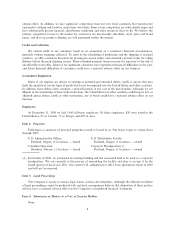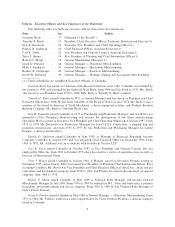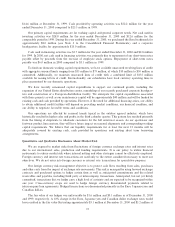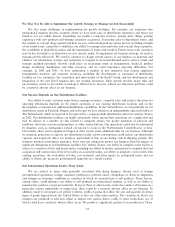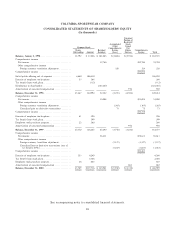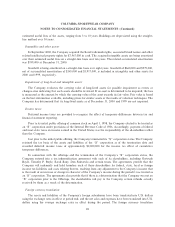Columbia Sportswear 2000 Annual Report Download - page 30
Download and view the complete annual report
Please find page 30 of the 2000 Columbia Sportswear annual report below. You can navigate through the pages in the report by either clicking on the pages listed below, or by using the keyword search tool below to find specific information within the annual report.We May Not Be Able to Implement Our Growth Strategy or Manage Growth Successfully
We face many challenges in implementing our growth strategies. For example, our expansion into
international markets involves countries where we have little sales or distribution experience and where our
brand is not yet widely known. Expanding our product categories involves, among other things, gaining
experience with new products and winning consumer acceptance. Increasing sales to department stores, and
the number of concept shops opened and their success, will each depend on various factors, including strength
of our brand name, competitive conditions, our ability to manage increased sales and concept shop expansion,
the availability of desirable locations and the negotiation of terms with retailers. Future terms with customers
may be less favorable to us than those we now operate under. To implement our business strategy, we need to
manage growth eÅectively. We need to continue to change certain aspects of our business, to maintain and
enhance our information systems and operations to respond to increased demand and to attract, retain and
manage qualiÑed personnel. Growth could place an increasing strain on management, Ñnancial, product
design, marketing, distribution and other resources, and we could experience operating diÇculties. For
example, in 2000 and 2001, we have undertaken a number of new initiatives that require signiÑcant
management attention and corporate resources, including the development or expansion of distribution
facilities on two continents, the acquisition and rejuvenation of the Sorel» brand, and the development and
integration of the new Sorel business into our existing operations. Such growth involves many risks and
uncertainties, and if we are unable to manage it eÅectively we may not achieve our objectives and there could
be a material adverse aÅect on our business.
Our Success Depends on Our Distribution Facilities
Our ability to meet customer expectations, manage inventory, complete sales and achieve objectives for
operating eÇciencies depends on the proper operation of our existing distribution facilities and on the
development or expansion of additional distribution capabilities. In the United States, we rely primarily on our
distribution center in Portland, Oregon, and in Europe we have relied on an independently operated facility in
The Netherlands, which is expected to be replaced by a company-built distribution center in Cambrai, France
in 2002. Our distribution facilities are highly automated, which means their operations are complicated and
may be subject to a number of risks related to computer viruses, the proper operation of software and
hardware, electronic or power interruptions, or other system failures. Our operations could also be interrupted
by disasters, such as earthquakes (which are known to occur in the Northwestern United States) or Ñres.
Uncertainty about power supplies in Oregon in 2001 creates some additional risks for our business. Although
we maintain generators to operate our distribution facility, power interruptions could restrict our distribution
capacity and negatively aÅect our business, particularly if this occurs during critical shipping periods. We
maintain business interruption insurance, but it may not adequately protect our business from the impact of
signiÑcant disruptions in our distribution facilities. In Cambrai, France, our ability to complete a new facility is
subject to a number of risks and uncertainties, including our ability to Ñnalize agreements to complete the land
acquisition and construction of the new facility on acceptable terms, our ability to integrate a new facility with
existing operations, the availability of labor, raw materials and other inputs on anticipated terms and our
ability to obtain any necessary governmental approvals in a timely fashion.
Our International Operations Involve Many Risks
We are subject to many risks generally associated with doing business abroad, such as foreign
governmental regulations, foreign consumer preferences, political unrest, disruptions or delays in shipments
and changes in economic conditions in countries in which we manufacture or sell products. These factors,
among others, could inÖuence our ability to sell products in international markets, as well as our ability to
manufacture products or procure materials. If any of these or other factors make the conduct of business in a
particular country undesirable or impractical, there could be a material adverse aÅect on our business. In
addition, many of our imports are subject to duties, tariÅs or quotas that aÅect the cost and quantity of certain
types of goods imported into the United States or into our other sales markets. The countries in which our
products are produced or sold may adjust or impose new quotas, duties, tariÅs or other restrictions, any of
which could have a material adverse eÅect on us. We produce a signiÑcant portion of our products in China,
18


